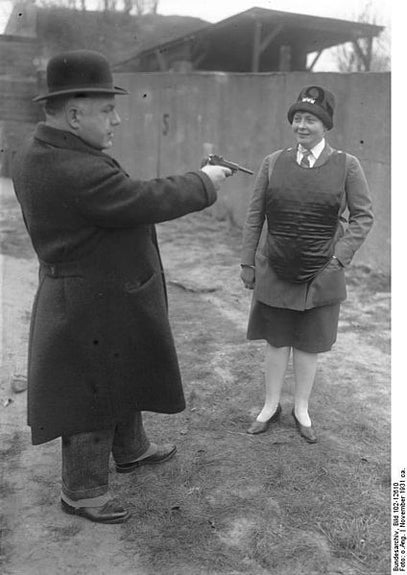Collection: The History of the Bulletproof Vest

Throughout history, people have protected themselves from injury with different types of materials. In the earliest days, people used animal skins as barriers to injury and attacks. As weaponry advanced, they added wooden and metal shields to their defensive arsenals.
In the 1500s, Italian and Roman royalty experimented with the idea of bullet proof vests. They built body armor with layers of metal that were meant to deflect bullets. The outer layer was designed to absorb the bullet's impact, while the inner layer was added to stop further penetration. However, metal body armor was largely ineffective against firearms.
In the 1800s, softer body armor was developed by the Japanese, who made the armor from silk. These silk garments proved to be quite effective but also expensive.
After President William McKinley was assassinated in 1901, the US military explored the use of soft body armor as well. The silk-derived garments were shown to be effective against low-velocity bullets, but not the new generation of handgun ammunition. The US military decided against silk armor because of this, combined with the high price of silk.
The flak jacket was invented during World War II. It was made from ballistic nylon and provided protection from ammunition fragments. Flak jackets were bulky and ineffective against most rifle and pistol fire, but they were widely used, as they provided some modicum of protection and allowed soldiers to feel secure.
In the 1960s, new fibers were discovered that made truly bullet resistant vests possible. In the early 1970s, DuPont’s Kevlar ballistic fabric was invented. The fabric was originally intended to replace steel belting in tires, and it was extremely strong. Waterproofing and additional layers of fabric were added to the Kevlar to make the vests more durable and wearable. The National Institute of Justice tested versions of Kevlar vests for several years, and found that the vests could stop the most common lead bullets: 38 Specials and 22 Long Rifle Bullets.
A final phase of testing monitored Kevlar armor’s effectiveness. Kevlar armor was found to ensure a 95% probability of survival after being hit with a .38 caliber bullet at a velocity of 800 ft/second. The probability of requiring surgery after being hit by a projectile was found to be 10% or less.
In 1976, scientists came to the conclusion that Kevlar was bullet-resistant, wearable and light enough for police officers to wear full-time. The funny thing was that bulletproof vests had already become commercially available, even before the National Institute of Justice published these claims.
Since that time bulletproof vests have improved. Currently, a level IIIA bulletproof vest weighs approximately 5.5 pounds and can protect the wearer from almost all handgun rounds. According to the International Association of Chiefs of Police, bulletproof vests have saved over 3,000 officers' lives since 1987.
